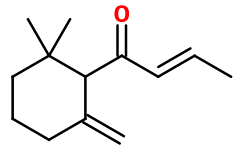Damascone-Gamma®
Synthétique
Fruity > Berries > Coniferous > Spicy

Crédits photo: ScenTree SAS
Other names :
Gamma-damascone ; 1-(2,2-dimethyl-6-methylene cyclohexyl)-2-buten-1-one
Volatility :
Heart/Base
Uses in perfumery :
Gamma-Damascone® can be used to make the link between a fruity and a coniferous note, to bring a cooked fruit effect. It also brings a dirty aspect to a composition, in association with aromatic notes.
Natural availability :
Gamma-Damascone® is not found on a natural state. Thus, it is impossible to extract it in any way.
Year of discovery :
First damascones were discovered in 1965 by chemists P. Ruzicka and Dr. Demole, by anayzing an extract as Damask Rose Absolute. This discovery showed the way to a new rosy and fruity molecule family.
Other comments :
Gamma-Damascone® is the most particular damascone. It has a confirous facet that makes it very different.
Price Range :
€€€
Stability :
Stable in perfumes and in various functional bases, except very alkaline bases as liquid bleach or some detergents.

Crédits photo: ScenTree SAS
- Molecular formula :
- C13H20O
- Molecular Weight :
- 192,3 g/mol
- Density :
- 0,93
- Flash Point :
- 98°C
- Fusion Point :
- Donnée indisponible.
- Appearance :
- Colorless to pale yellow liquid
- Log P :
- 4,11
- Boiling Point :
- 267°C
- Detection Threshold :
- Donnée indisponible.
Synthesis route :
Gamma-Damascone® belongs to the ''rose-ketones '' family. Rose ketones are synthesized thanks to the appropriate cyclogeranic acid derivative (ester, halide…). Reacting this derivative with an allyl magnesium halide, followed by subsequent pyrolysis, leads to the desired compound, by rearranging the double bond of the branched chain.
Synthesis precursor :
Gamma-Damascone® is not a precursor for the synthesis of another olfactive compound.
Isomerism :
''Rose ketone '' family contains a few different molecules, almost all evoking cooked apple, blackcurrant and Damask Rose Absolute. Gamma-Damascone® has the most particular smell, with a coniferous facet, close to Thuyone, that makes its distinction. Beta-Damascone® and Alpha-Damascone® are both more rosy and minty.
Alpha-Ionone and Beta-Ionone are both positional isomers of Damascone® molecules, because their ketone function is located on another carbon, and as they have a relocated methyl function. Nevertheless, their smell is very different, as Ionones are reminiscent of violet flower.
- EINECS number :
- 481-910-9
- FEMA number :
- Donnée indisponible.
- JECFA number :
- Donnée indisponible.
- FLAVIS number :
- Donnée indisponible.
- Allergens :
- This ingredient does not contain any allergen.
- IFRA :
- This ingredient is restricted by IFRA
- Restriction type :
- RESTRICTION
- Cause of restriction :
- DERMAL SENSITIZATION
- Amendment :
- 49
- Comments :
- The above limits apply to Rose Ketones used individually or in combination. The sum of concentrations of Rose ketones isomers should not exceed the maximum concentration levels established by this Standard.
- Quantitative limit on the use :
-
Cat.1 Cat.2 Cat.3 Cat.4 Cat.5A Cat.5B Cat.5C Cat.5D Cat.6 0,0077 % 0,0023 % 0,046 % 0,043 % 0,011 % 0,011 % 0,011 % 0,011 % 0,025 % Cat.7A Cat.7B Cat.8 Cat.9 Cat.10A Cat.10B Cat.11A Cat.11B Cat.12 0,088 % 0,088 % 0,0045 % 0,084 % 0,3 % 0,3 % 0,17 % 0,17 % No Restriction - Restriction type :
- RESTRICTION QRA
- Cause of restriction :
- Amendment :
- 44
- Comments :
- The above limits apply to Rose Ketones used individually or in combination. The sum of concentrations of Rose ketones isomers should not exceed the maximum concentration levels established by this Standard.
- Quantitative usage limits :
-
Cat.1 Cat.2 Cat.3 Cat.4 Cat.5 Cat.6 Cat.7 Cat.8 Cat.9 Cat.10 Cat.11 0,003 % 0,004 % 0,02 % 0,02 % 0,02 % 0,07 % 0,008 % 0,02 % 0,02 % 0,02 % Not Restricted
To learn more about IFRA's standards : https://ifrafragrance.org/safe-use/library
ScenTree is solely responsible for the information provided here.

